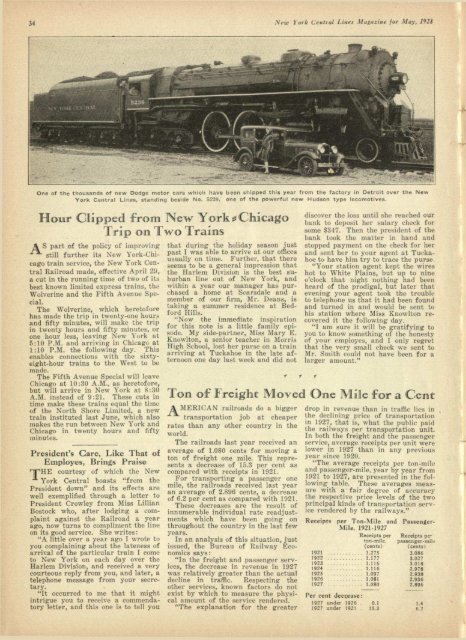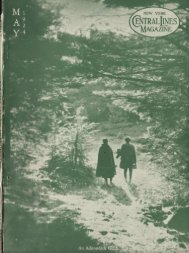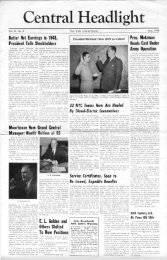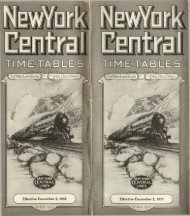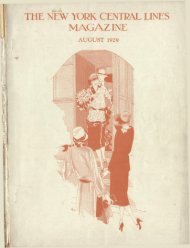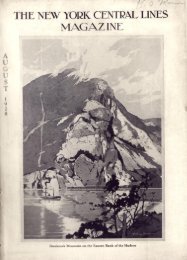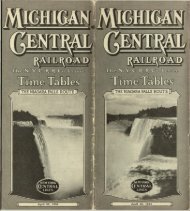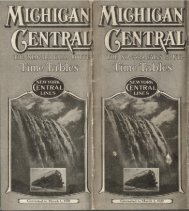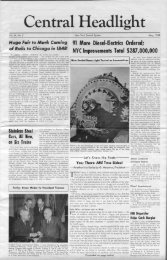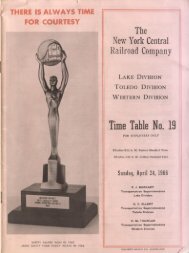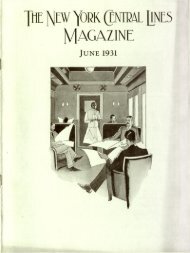You also want an ePaper? Increase the reach of your titles
YUMPU automatically turns print PDFs into web optimized ePapers that Google loves.
34<br />
New York Central Lines Magazine for May, 1928<br />
One of the thousands of new Dodge motor cars which have been shipped this year from the factory in Detroit over the New<br />
York Central Lines, standing beside No. 5239. one of the powerful new Hudson type locomotives.<br />
H o u r C l i p p e d f r o m<br />
S part of the policy of improving<br />
still further its New York-Chicago<br />
train service, the New York Central<br />
Railroad made, effective April 29,<br />
a cut in the running time of two of its<br />
best known limited express trains, the<br />
Wolverine and the Fifth Avenue Special.<br />
The Wolverine, which heretofore<br />
has made the trip in twenty-one hours<br />
and fifty minutes, will make the trip<br />
in twenty hours and fifty minutes, or<br />
one hour less, leaving New York at<br />
5:10 P.M. and arriving in Chicago at<br />
1:10 P.M. the following day. This<br />
enables connections with the sixtyeight-hour<br />
trains to the West to be<br />
made.<br />
The Fifth Avenue Special will leave<br />
Chicago at 10:30 A.M., as heretofore,<br />
but will arrive in New York at 8:30<br />
A.M. instead of 9:21. These cuts in<br />
time make these trains equal the time<br />
of the North Shore Limited, a new<br />
train instituted last June, which also<br />
makes the run between New York and<br />
Chicago in twenty hours and fifty<br />
minutes.<br />
President's Care, Like That of<br />
Employes, Brings Praise<br />
TPHE courtesy of which the New<br />
York Central boasts "from the<br />
President down" and its effects are<br />
well exemplified through a letter to<br />
President Crowley from Miss Lillian<br />
Bostock who, after lodging a complaint<br />
against the Railroad a year<br />
ago, now turns to compliment the line<br />
on its good service. She writes:<br />
"A little over a year ago I wrote to<br />
you complaining about the lateness of<br />
arrival of the particular train I come<br />
to New York on each day over the<br />
Harlem Division, and received a very<br />
courteous reply from you, and later, a<br />
telephone message from your secretary.<br />
"It occurred to me that it might<br />
intrigue you to receive a commendatory<br />
letter, and this one is to tell you<br />
T r i p o n T w o Trains<br />
e w Y o r k 0 C h i c a g o<br />
that during the holiday season just<br />
past I was able to arrive at our offices<br />
usually on time. Further, that there<br />
seems to be a general impression that<br />
the Harlem Division is the best suburban<br />
line out of New York, and<br />
within a year our manager has purchased<br />
a home at Scarsdale and a<br />
member of our firm, Mr. Deans, is<br />
taking a summer residence at Bedford<br />
Hills.<br />
"Now the immediate inspiration<br />
for this note is a little family episode.<br />
My side-partner, Miss Mary E.<br />
Knowlton, a senior teacher in Morris<br />
High School, lost her purse on a train<br />
arriving at Tuckahoe in the late afternoon<br />
one day last week and did not<br />
discover the loss until she reached our<br />
bank to deposit her salary check for<br />
some $347. Then the president of the<br />
bank took the matter in hand and<br />
stopped payment on the check for her<br />
and sent her to your agent at Tuckahoe<br />
to have him try to trace the purse.<br />
"Your station agent kept the wires<br />
hot to White Plains, but up to nine<br />
o'clock that night nothing had been<br />
heard of the prodigal, but later that<br />
evening your agent took the trouble<br />
to telephone us that it had been found<br />
and turned in and would be sent to<br />
his station where Miss Knowlton recovered<br />
it the following day.<br />
"I am sure it will be gratifying to<br />
you to know something of the honesty<br />
of your employes, and I only regret<br />
that the very small check we sent to<br />
Mr. Smith could not have been for a<br />
larger amount."<br />
T o e o f Freight M o v e d O n e M i l e f o r a C e n t<br />
J\ MERICAN railroads do a bigger drop in revenue than in traffic lies in<br />
transportation job at cheaper<br />
t h e<br />
declining price of transportation<br />
rates than any other country in the Iv "27' that ' S<br />
' W h a t t h e<br />
f P^lic P a<br />
-V d<br />
,<br />
w o r l d<br />
-<br />
The railroads last year received an<br />
average of 1.080 cents for moving a<br />
ton of freight one mile. This represents<br />
a decrease of 15.3 per cent as<br />
compared with receipts in 1921.<br />
For transporting a passenger one<br />
the railways per transportation unit.<br />
In both the freight and the passenger<br />
service, average receipts per unit were<br />
lower in 1927 than in any previous<br />
y e a<br />
m c e<br />
,L,? 1920.<br />
T h e<br />
, average receipts per ton-mile<br />
and passenger-mile, year by year from<br />
} 92<br />
} t o 19<br />
2, 7<br />
» a r e<br />
mile, the railroads received last year<br />
presented m the fol-<br />
'owing table. These averages measan<br />
average of 2.896 cents, a decrease<br />
of 6.2 per cent as compared with 1921.<br />
These decreases are the result of<br />
r e W a<br />
" degree of accuracy<br />
t h e<br />
respective price levels of the two<br />
principal kinds of transportation servinnumerable<br />
individual rate readjustl<br />
c e<br />
rendered by the railways."<br />
ments which have been going on<br />
throughout the country in the last few<br />
Receipts per Ton-Mile and Passenger-<br />
Mile, 1921-1927<br />
years. .... . Receipts per Receipts pe-<br />
In an analysis of this Situation, JUSt<br />
issued, the Bureau of <strong>Railway</strong> Economics<br />
says:<br />
"In the freight and passenger services,<br />
the decrease in revenue in 1927<br />
was relatively greater than the actual<br />
decline in traffic. Respecting the<br />
other services, known factors do not<br />
exist by which to measure the physical<br />
amount of the service rendered.<br />
"The explanation for the greater<br />
ton-mile<br />
(cents)<br />
1921 1.275<br />
*323 \'\H<br />
1924 i!ii6<br />
1925 1.097<br />
9 2 6 1 0 8 1<br />
\<br />
1 0 8 0<br />
•<br />
p e r e e n t deccease:<br />
1927<br />
under 1926 01<br />
1927 under 1921". 15.3<br />
passenger-mil:<br />
(centsi<br />
3.086<br />
inVg<br />
2^978<br />
2.938<br />
2<br />
«6<br />
2 , 8 9 6<br />
14<br />
6.2<br />
York Central Lines Magazine for May, 1928 35<br />
New Freight House Opens at<br />
North Tonawanda<br />
'II'MIK new freight house of the New<br />
York Central at North Tonawanda,<br />
X. V., is now in use with telephones,<br />
Furniture and all other equipment<br />
complete.<br />
Since fire destroyed the former<br />
building, the Railroad freight office<br />
has been quartered in the passenger<br />
station on Main Street.<br />
The new freight house is of brick<br />
and steel construction. Every provision<br />
has been made for the comfort<br />
if the public using the building, as<br />
well as for the freight house employes.<br />
The building, trackage property<br />
i>nd equipment cost the New York<br />
Central $150,000. The commodious<br />
freight office on the second floor is<br />
thirty by seventy-five feet, wherein<br />
are located a private office for Harvey<br />
Varley, Agent, the general office,<br />
a record room, lockers and toilets for<br />
the men and women employes.<br />
The offices are equipped with steel<br />
('esks, chairs and tables. Lighting<br />
equipment is of the ceiling type.<br />
The freight house has a twentyfour<br />
car spot on the house platform<br />
and two team tracks with a nine-car<br />
spot each. There is room for additional<br />
team tracks as the business demands<br />
them. The house platform is<br />
equipped with an electrically operated<br />
crane for Hading and unloading heavy<br />
machinery.<br />
N.Y. Central Man Comes to Aid<br />
of Shipper, Procures<br />
New Traffic<br />
HE Buffalo Floor Covering Com<br />
T<br />
pany was having considerable trou<br />
ble with its shipments over another<br />
railroad. They "simply could not get<br />
anywhere. It came to a climax when<br />
a large shipment was lost somewhere,<br />
goodness knows where."<br />
Continuing, G. S. Reimann, of the<br />
Company, writes Assistant General<br />
Freight Agent Taylor of the New<br />
York Central:<br />
"A man by the name of F. Schosek<br />
in your office employ came to our<br />
rescue and did as much as anyone<br />
could do working for another railroad.<br />
He finally located our lost shipment<br />
about two days later and convinced me<br />
that it would be to our advantage to<br />
do all our shipping over the New York<br />
Central Lines.<br />
"Since then we have had peace with<br />
our customers and you can rest assured<br />
we will continue to patronize<br />
your railroad as long as we have any<br />
shipments coming in."<br />
Mr. Schosek is employed on the Revision<br />
Bureau Desk at the Carroll<br />
Street Station, Buffalo.<br />
Cleveland Being Advertised by<br />
Union Trust Company<br />
T<strong>TH</strong>E growth of Cleveland and the<br />
importance of its industries and its<br />
railroads are being emphasized in a<br />
series of advertisements published by<br />
the Union Trust Company of Cleveland.<br />
"Cleveland's on the Assembly Line"<br />
is the title of the first advertisement,<br />
Crater Lake, in Crater Lake National Park, Oregon, Is one of the notable scenic<br />
beauties of the West visited annually by travelers from every continent, as well as<br />
from all parts of the United States. The phantom ship shows In the water above,<br />
near the rim of the lake at the right.<br />
which is illustrated with a bird's-eye<br />
view of the waterfront" from which the<br />
new terminal of the New York Central<br />
rises head and shoulders above all<br />
other buildings. The terminal, costing<br />
$60,000, will soon be ready for use.<br />
The gist of the advertisement is,<br />
from an excerpt: "Cleveland's location,<br />
her railroads, her harbor, manufacturing,<br />
finance, steel—all these<br />
things are ready and waiting.<br />
"The present generation of Clevelanders<br />
has a glorious and inspiring<br />
opportunity, upon the realization of<br />
which depends much of the prosperity<br />
and happiness of every Clevelander.<br />
"Cleveland is in the making—help<br />
make it. You can't grow against your<br />
town, you've got to grow with it."<br />
War Veteran Receives Kindly<br />
Care on Train<br />
DISABLED war veteran re<br />
A ceived the customary New York<br />
Central courteous and thoughtful<br />
service when he was transferred from<br />
Beacon, N. Y., to New York City,<br />
March 6. In gratitude, Terence<br />
Newsome, Business Manager of the<br />
Veterans' Hospital.of Beacon, writes:<br />
"In connection with a report submitted<br />
to this office by one of our<br />
Ward Surgeons who accompanied a<br />
patient on the 10:29 A.M. train yes<br />
terday from Beacon to New York, we<br />
cannot neglect to write this letter of<br />
commendation for the wonderful service<br />
rendered by the personnel of the<br />
Railroad Company.<br />
"Not only did the Agent at Beacon,<br />
N. Y. (J. W. Moate) hold the train<br />
several minutes for the transfer of<br />
this patient, but the train conductor,<br />
Pullman conductor and porter went to<br />
a lot of trouble to get this patient<br />
properly looked after and comfortably<br />
arranged.<br />
"Upon arrival at Grand Central<br />
Terminal, again special attention was<br />
shown for the interest of this disabled<br />
veteran, all of which is sincerely appreciated,<br />
and it is gratifying to know<br />
that all emnloyes who came in contact<br />
with this patient rendered kind,<br />
efficient and loyal service."<br />
New Road Foremen<br />
William H. Gott has been promoted<br />
to Road Foreman of Engines on the<br />
Syracuse Division. Owen McEvoy<br />
and Charles Smith have been raised<br />
to the same position on the Mohawk<br />
and Hudson Divisions respectively,<br />
effective since March 29.<br />
Mr. Gott is the father-in-law of Al<br />
Smith. Jr., son of the Governor of<br />
New York. He entered the service in<br />
1890.


